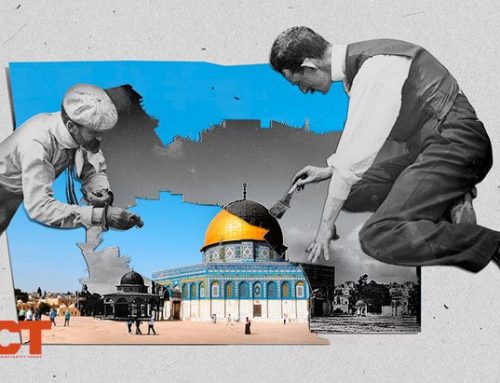The search for biblical treasures starting in the 19th century fundamentally changed the way Westerners, including Jews, saw Jerusalem. The consequences were enormous
By Andrew Lawler, Published January 3, 2022
This newfound fascination with Jerusalem also was wrapped up with the Protestant idea that the Jews must return to the Holy Land to enable the second coming of Jesus. This interpretation of scripture became increasingly influential in the mid-19th century.
These Protestant “Christian Zionists” helped found the Palestine Exploration Fund, a British society organized in 1865 with Queen Victoria’s assent, following surveys of Palestine in general and Jerusalem in particular. The fund sent British military officers to map the territory beneath Jerusalem in the hopes of finding the tombs of David and Solomon, the vanished Temple treasures, and other artifacts relating to the Old Testament. One of the most adventurous of these was Charles Warren, a pious Anglican known to use gunpowder to blast his way through blocked passages. This practice unnerved Arab Muslims, who suspected his true goal was to undermine the “Noble Sanctuary”, or Temple Mount.
The excavators found no Solomonic gold or silver, but the tunnels they burrowed and exposed garnered widespread press attention. These quickly became major attractions for the European and American tourists who now flocked to the city, thanks to new steamboat lines and a more welcoming Ottoman regime. Jerusalem became a destination for thousands of curious Westerners, mainly Protestants with disposable incomes. They were often repelled by Catholic and Greek Orthodox shrines celebrating Jesus and Mary, which they viewed as idolatrous. Instead, they were drawn to digs by Warren and his colleagues, who were seeking to unearth evidence of the kings and prophets of the Old Testament,
Meanwhile, many Muslim Arab and Sephardic Jewish residents of Jerusalem remained hostile to digs that they feared threatened the foundations of their homes and sacred sites. The small but growing community of Ashkenazi Jews, however, were intrigued. In the late 1860s, Warren took a group of local Ashkenazi rabbis on a subterranean tour, guiding them past treacherous pits and open cisterns of what is now part of the Western Wall Tunnels complex – a tunnel that exposes the foundation of the wall over hundreds of meters beneath the Muslim Quarter.
“I was very much afraid I should lose a few rabbis,” Warren wrote later, “but fortune favored us.” Even when some rubble collapsed on the party, the visitors didn’t complain, he wrote: “We had come for sightseeing, so they did not mind a few bruises.” Later, the rabbis invited him to a special ceremony in their synagogue where they offered prayers for this devout Christian who also was an early advocate for Jewish control of Palestine. They even proposed raising a subscription to publish his reports in Hebrew.
By the 1890s, increasing numbers of Jewish tourists from America and Europe were flocking to Jerusalem to see the city’s “biblical underground” as well as visit holy places like the Western Wall, then popularly known as the “Wailing Wall.”
Early advocates of Jewish settlements in Palestine took note. The stony countryside with its overwhelmingly Muslim majority might seem not to have had much inherent appeal, but the city’s biblical fame combined with the concrete revelations by excavators gave the Holy Land a fresh romantic, as well as spiritual, allure.
On his one and only visit to the city, where he met the German Kaiser in 1898, Theodor Herzl recoiled at the “inhumanity, intolerance, and foulness” in Jerusalem’s “reeking alleys.”
But like many educated Westerners of his day, the author of The Jewish State was fascinated with archaeology; he had attended lectures on the topic while in Egypt. Herzl visited the excavations in Jerusalem and had his picture taken at the “Tomb of the Kings.” Much to his dismay, the site had been acquired by the French government. “This is how impossible people would consider it that the Jews ever own anything themselves,” Herzl fumed.
But it would take another scandal to convince Jews to enter the archaeological fray. In 1909, the British aristocrat Montagu Parker led a nominally Christian team in an intensive search beneath Jerusalem for the Temple treasures, including the Ark of the Covenant. They sold shares in a company they hoped would reap a fortune from the sale of these objects on the art market. The project failed spectacularly two year later when the Europeans were discovered hacking away at the stone beneath the Dome of the Rock. This set off Arab Muslim riots and sparked a political crisis that rattled the British Empire and nearly brought down the Ottoman government in Istanbul
Until then, Jews had remained on the sidelines in the search for the biblical past. But this bungled effort attracted Jewish ire. “We, who should be the most interested party in these archaeological excavations, do almost nothing in this field and leave to whomever else wants it: Germans, Americans, British,” complained David Smilanski in a 1912 Russian-Jewish newspaper.
Parisian banker Edmond de Rothschild did something. He purchased land on the ridge south of the city’s acropolis in the area of the original City of David. With his financial backing, a former French military officer named Raymond Weill in 1913 launched the Holy Land’s first Jewish-led excavation.
The public goal was to find the tombs of David and Solomon. Yet science was an afterthought in what was really a race between European Jews and Christians to obtain the world’s most famous sacred object. When Chaim Weizmann, later Israel’s first president, questioned Rothschild, the Parisian was clear that “his purpose was to uncover the Ark of the Covenant, which he believed was buried there.” He added to Weizmann: “Excavations be damned, it’s possession that counts.”
Like de Saulcy before him, Weill uncovered no treasure, and his assertion that he had found early royal Judean tombs was later dismissed by most scholars. His efforts, however, were cut short by the start of World War I, which forced all British and French citizens to leave Jerusalem. Shortly before that crisis, a group of Jewish Europeans, inspired both by Weill’s dig and Zionism, founded the Society for the Reclamation of Antiquities.
Though short-lived, it would serve as the seed for what became the Israel Exploration Society, Judaism’s answer to the question Smilanski posed in 1912.
After World War I, when the British replaced the Ottomans as Jerusalem’s overseer, secular Zionists retained a distaste for what many considered a medieval and superstitious place ill-suited as the capital of a modern socialist state. (“I would not accept the Old City even if they gave it to me for free,” Weizmann declared in the 1930s).
Yet there was no denying the power that excavated sites like the Tomb of the Kings and the City of David exerted over Jewish visitors. Biblical archaeology had established physical proof of an ancient Jewish tie to the city. The Holocaust and the 1948 war would intensify that emotional attachment to Jerusalem.
When East Jerusalem fell to Israeli control in 1967, the Christian archaeologists who had dominated the city’s underground for a century were replaced with Jewish excavators. They turned digs in and around the Old City into a national obsession, but they were simply expanding what their predecessors had begun. If you venture beneath Jerusalem today, you will still find traces of the rough-cut tunnels and passages made by those Western Christians who helped turn Jerusalem from a small and dusty pilgrimage town into a major tourist destination that eventually became Israel’s capital—and the world’s most contested city




